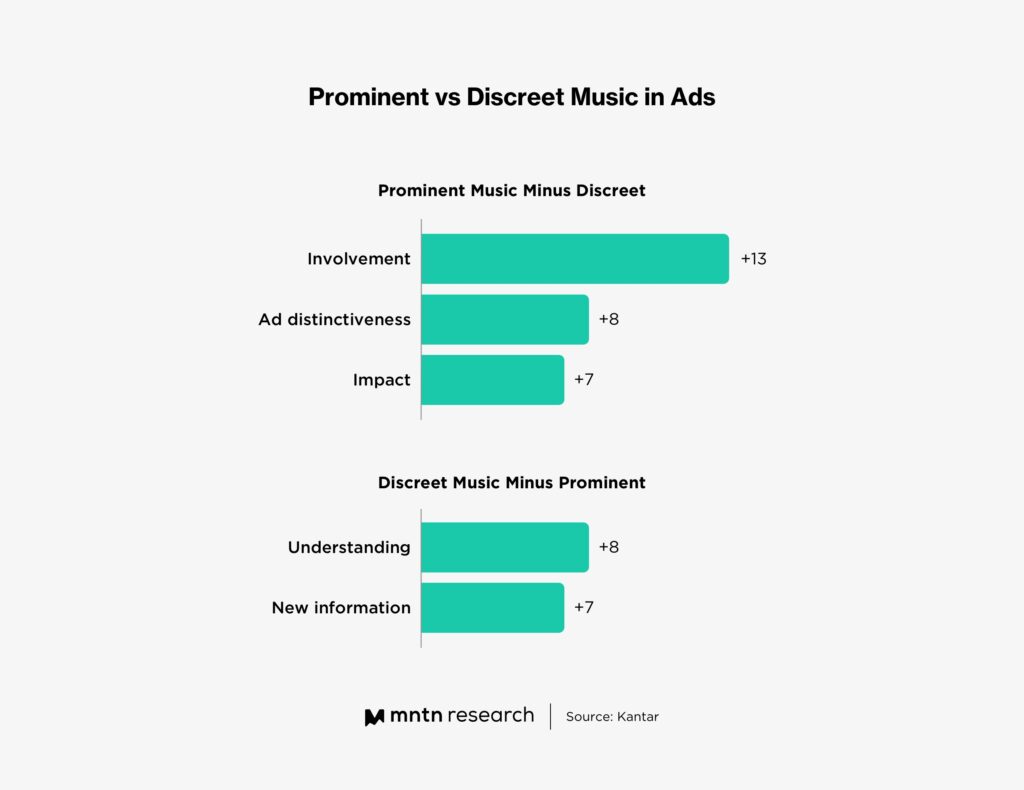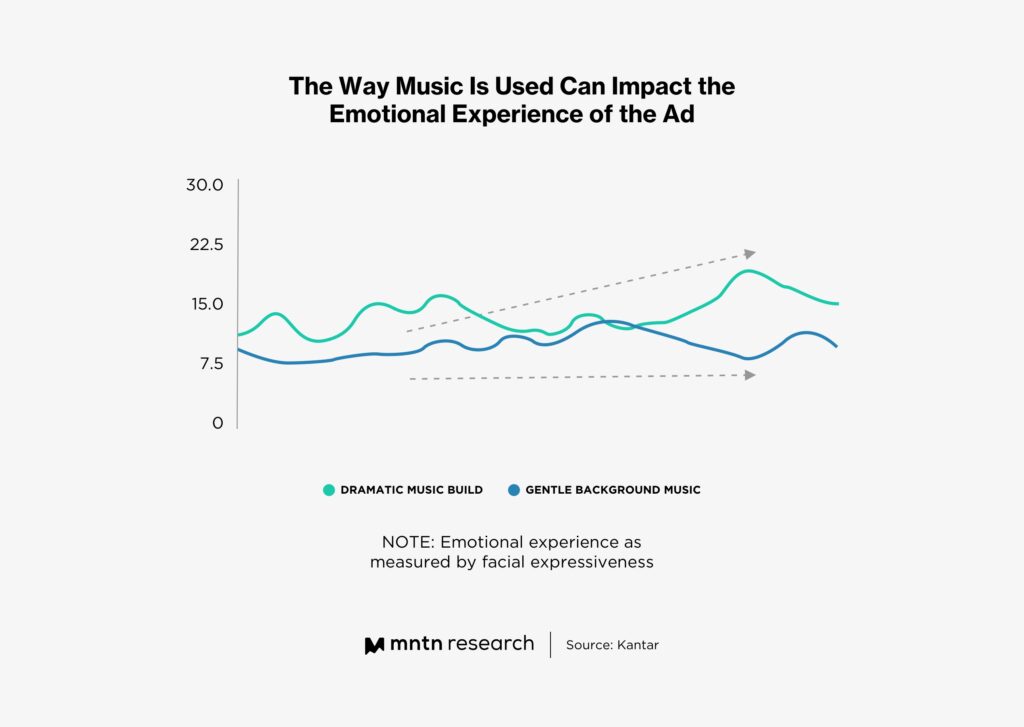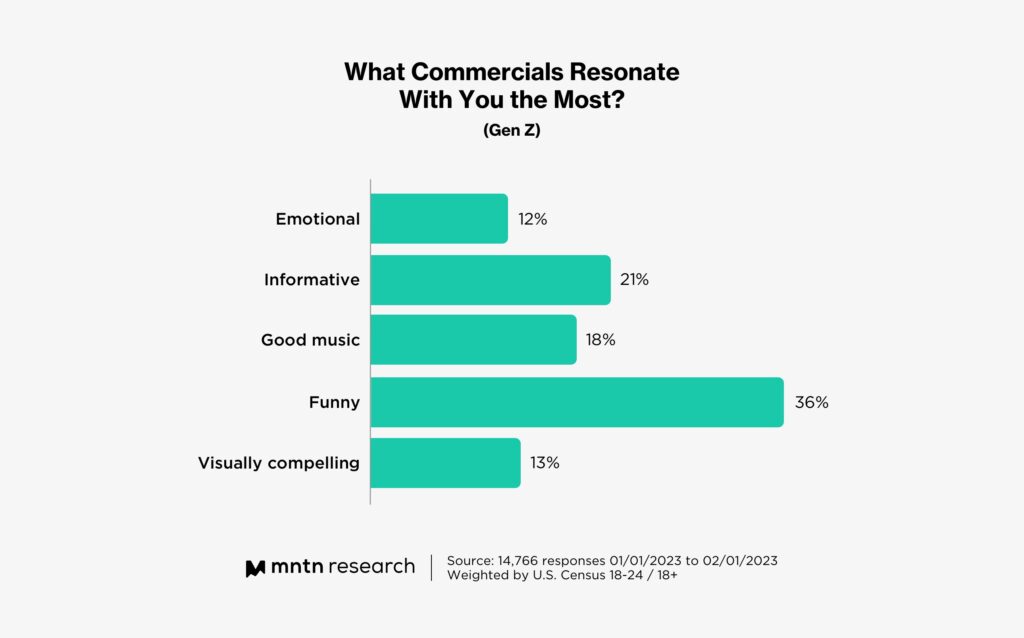Research Digest
Music to Our Ears: What Makes a Perfect Melody on a Connected TV Ad?
by Melissa Yap5 min read
Abstract
- Music choice matters in a CTV ad. The right music drives engagement and solidifies brand loyalty.
- Music style matters, whether it be subtle or prominent. What you choose should depend on the type of messaging you want to convey.
- Generation Z viewers connect better with music in ads than their other generational counterparts.
When you hear the chorus of Sarah McLachlan’s “Angel,” what immediately comes to mind? And why is it the ASPCA sad puppy commercial? Whether it’s a movie, television show, or commercial, the right music can set the tone and make viewers feel some type of way. But what actually turns a memorable jingle into a converted customer? And how can you build a better relationship with viewers through something as simple as a choice of soundtrack? This MNTN Research article investigates music’s impact on different types of audiences and generations, including the styles and formats that brands should keep in mind when concepting their Connected TV commercial.
The Relationship Between Sound and Emotion
A study published in BMC Neuroscience suggests we use the same parts of the brain when processing music as we do when processing emotions and memory, and that even a simple change in chord or key can elicit a different response. Audio branding company PHMG conducted a study with over 1,000 consumers, each exposed to different audio clips, and found that short and sharp notes in a major key drove happiness and excitement in 87% of respondents, while shifting from major to minor keys elicited sadness and melancholy in 83% of respondents.
The study goes even further by looking at instrumentation, and how that might have an impact:
- Acoustic guitar: Had a calming and overall positive effect, especially when played in a major key
- Drums: Drove urgency, motivation and energy when played faster than a standard 4/4 time signature, but drove the opposite emotions when played at a slower tempo
- Acoustic guitar: Had a calming and overall positive effect, especially when played in a major key
- Drums: Drove urgency, motivation and energy when played faster than a standard 4/4 time signature, but drove the opposite emotions when played at a slower tempo
- Brass: Elicited feelings of anger, sadness or pensiveness when played in open fifths
These studies pinpoint the format that drives different emotive responses, but which formula(s) works for sticking around in long-term memory for Connected TV ads? It turns out that matching the tempo of your ad to your music makes for the perfect beat. Case in point: the new AirPods Pro ad, which features floating cars paired with ambient acoustics to evoke a feeling of reverie amid a busy cityscape.
The (Not-So-) Subtleties of Music and Performance
Not every track is created equal—in fact, certain types of music lend themselves better, depending on what you’re trying to communicate with the viewer. A research study by Kantar, a data analytics and brand consulting company, explored the impact of prominent versus discreet music in ads.

The results above show the difference in average percentile scores. Prominent music is more effective at connecting with the viewer. Logically, this makes sense depending on whether you want your music to act as the ad’s centerpiece, or as a complementary creative element (i.e. as background music). This Coca-Cola “Masterpiece” ad is a prime example of an ad using prominent music, with a pattern of crescendos and decrescendos, like those found in movie scores, to build up excitement, fascination, and wonder—all in the span of a minute.
Discreet music, meanwhile, better solidifies understanding of your brand and conveys news. Many pharmaceutical brands utilize this approach in their commercials, since the complexity of their products often requires sending a clear message to the viewer.
Where you choose to place your music moment also impacts its resonance with viewers. The chart below tracks the facial expressions of viewers across the same ad, with slight tweaks to the music. Both ads begin and end mellow, however one of the ads has a music build, while the other stays relatively flat throughout. As the music intensifies, so does the viewer’s reaction to it. Connected TV advertisers should keep this in mind when storyboarding their ads—landing your brand message or moment with a simultaneous crescendo or meaningful chord can create maximum impact and ensure your relationship with viewers always ends on a high note.

Mind the (Generational) Gap
Advertisers can learn a thing or two from Generation Z, who are the most receptive to music of all generations. A study by the Harris Poll revealed that 76% of Gen Z and Young Millennials (adults 18-29) are most likely to listen to music, compared to 72% of all US adults.
- 35% of consumers rely more on promotions post-pandemic
- 39% constantly look for cheaper alternatives
Music also ranks as the top three factors that make up a good commercial, according to U.S. census data from January 2023.

Additionally almost half (44%) of Gen Z is likely to discover music and new artists via movies/TV shows, which makes it fertile ground for advertisers trying to reach users on these channels. Apply this same mindset to your CTV campaigns by experimenting with music from new and upcoming artists, for example (or hip hop/R&B, top 40, and alternative rock, which are their top genre preferences).
Stay in Tune and in Touch With Viewers on Connected TV
The best Connected TV ads are the ones that connect visually and audibly with audiences. Music plays a particularly important role in making your brand message stand out and resonate with viewers. Format, style, placement within a CTV commercial, even instruments used all have an impact on long-term memory and evoke different emotions depending on the combination used. However, some audiences (like Gen Z) are more receptive to music than others. Whichever tune you choose, don’t forget to apply a performance mindset—and maybe a cute dog or two (just a suggestion!)—and you’ve got a formula for success on this channel.
Subscribe to the MNTN Research Weekly
Sign up to receive a weekly feed of curated research, sent straight to your inbox.
Resources
1 Music, Memory and Emotion (National Library of Medicine)
2 Science of Sound: How Music Makes Advertising More Memorable (Econsultancy)
3 The Next Generation and Music Discovery: Implications for Brands (The Harris Poll)
4 What Types of Ads Resonate With Gen Z? (Civic Science)
5 Here’s How People Say They Discover New Music (Marketing Charts)
6 Gen Z in US Spend More Time With Music (High Resolution Audio)